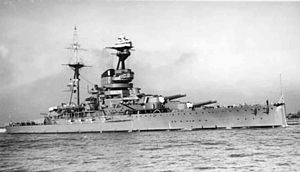HMS Resolution (09)

Resolution at anchor between the wars
|
|
| History | |
|---|---|
|
|
|
| Name: | HMS Resolution |
| Builder: | Palmers Shipbuilding and Iron Company, Jarrow |
| Cost: | £2,449,680 |
| Laid down: | 29 November 1913 |
| Launched: | 14 January 1915 |
| Commissioned: | 30 December 1916 |
| Identification: | Pennant number: 09 |
| Fate: | Sold for scrap, 5 May 1948 |
| General characteristics (as built) | |
| Class and type: | Revenge-class battleship |
| Displacement: |
|
| Length: | 620 ft 7 in (189.2 m) |
| Beam: | 88 ft 6 in (27.0 m) |
| Draught: | 33 ft 7 in (10.2 m) (Deep load) |
| Installed power: |
|
| Propulsion: |
|
| Speed: | 22 knots (41 km/h; 25 mph) |
| Range: | 7,000 nmi (12,960 km; 8,060 mi) at 10 knots (19 km/h; 12 mph) |
| Crew: | 1240 (1921) |
| Armament: |
|
| Armour: |
|
HMS Resolution (pennant number: 09) was one of five Revenge-class battleships built for the Royal Navy during World War I. Completed after the Battle of Jutland in 1916, she saw no combat during the war. The future First Sea Lord John H. D. Cunningham served aboard her as Flag Captain to Admiral Sir William Fisher, the commander-in-chief of the Mediterranean Fleet.
The Revenge-class ships were designed as slightly smaller, slower, and more heavily protected versions of the preceding Queen Elizabeth-class battleships. As an economy measure they were intended to revert to the previous practice of using both fuel oil and coal, but First Sea Lord Jackie Fisher rescinded the decision for coal in October 1914. Still under construction, the ships were redesigned to employ oil-fired boilers that increased the power of the engines by 9,000 shaft horsepower (6,700 kW) over the original specification.
Resolution had a length overall of 620 feet 7 inches (189.2 m), a beam of 88 feet 6 inches (27.0 m) and a deep draught of 33 feet 7 inches (10.2 m). She had a designed displacement of 27,790 long tons (28,240 t) and displaced 31,130 long tons (31,630 t) at deep load. She was powered by 2 sets of Parsons steam turbines, each driving two shafts, using steam from eighteen Yarrow boilers. The turbines were rated at 40,000 shp (30,000 kW) and intended to give the ship a maximum speed of 23 knots (42.6 km/h; 26.5 mph). During her sea trials on 22 May 1916, the ship only reached a top speed of 22 knots (41 km/h; 25 mph) from 40,360 shp (30,100 kW). She had a range of 4,200 nautical miles (7,778 km; 4,833 mi) at a cruising speed of 10 knots (18.5 km/h; 11.5 mph). Her crew numbered 909 officers and enlisted men in 1916. Her metacentric height was 3.4 feet (1.0 m) at deep load.
...
Wikipedia
